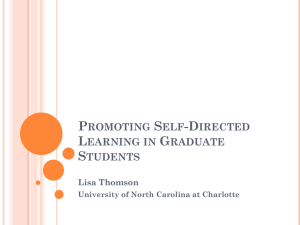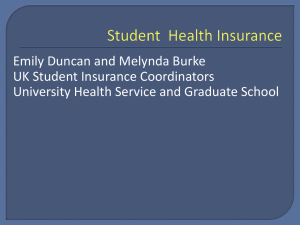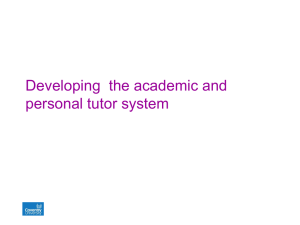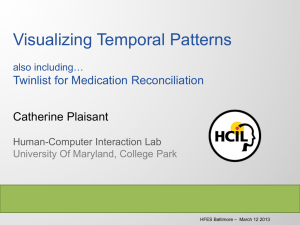UMCP Study on Defaults - DE-DC-MD
advertisement
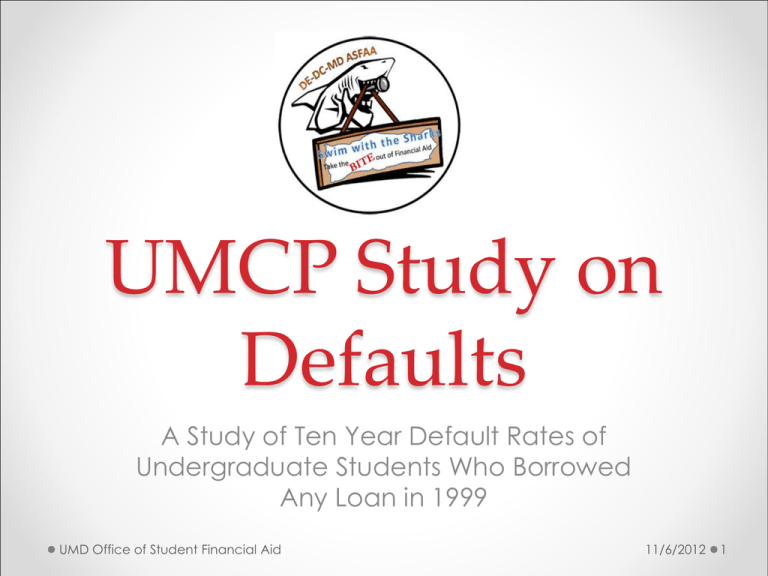
UMCP Study on Defaults A Study of Ten Year Default Rates of Undergraduate Students Who Borrowed Any Loan in 1999 UMD Office of Student Financial Aid 11/6/2012 1 Purpose and Scope The purpose of this study is to determine the indices that cause students to default on their student loans. • Describe the academic performance, demographics, and financial characteristics of students who defaulted. • Identify which characteristics are associated with the highest default rates. • Examine the correlation of graduation with each characteristic. UMD Office of Student Financial Aid 11/6/2012 2 Method • Cohort analysis: All undergraduate students who were enrolled in Fall 1999 and who took out any loan in aid year 1999 (N=9,865). • This cohort was matched to a report of all students from the University of Maryland who defaulted on their loan(s) from 2000 to 2010. UMD Office of Student Financial Aid 11/6/2012 3 Historical Default Rate • • UMCP’s default rate is consistently lower than the national average. The UMCP default rate ranges from 1.2% in FY 2005 to 3.9% in FY 2008. The average rate is 2.3%. UMD Office of Student Financial Aid 11/6/2012 4 Ten Year Default Rate A total of 404 (4% of 9,865) undergraduates who borrowed any loan in 1999 defaulted between 2000 and 2010. UMD Office of Student Financial Aid 11/6/2012 5 Default Rate by Graduation • Students that do not graduate have default rates more than three times higher than those that do graduate. UMD Office of Student Financial Aid 11/6/2012 6 Default Rate by Terms Enrolled • While students who graduated were less likely to default regardless of the number of terms enrolled, students enrolled in more than 12 terms but did not graduate were four times more likely to default than those that did graduate. UMD Office of Student Financial Aid 11/6/2012 7 Default Rate by Transfer Status • One-third of the students in the cohort initially enrolled as transfer students. Transfer students were at a slightly higher risk of defaulting (4.7% default rate) when compared to nontransfer students (3.8% default rate). • Among those who did not graduate, transfer students had a slightly lower default rate. UMD Office of Student Financial Aid 11/6/2012 8 Default Rate by High School GPA • Students with low high school GPAs were much more likely to default regardless of whether they completed their undergraduate degree. Almost one in five students with low high school GPAs who did not graduate from college defaulted on their loans. UMD Office of Student Financial Aid 11/6/2012 9 Default Rate by UG GPA * • Students with higher cumulative undergraduate GPAs were less likely to default. • Those with a high GPA (3.4-4.0) who did not graduate had default rates similar to the general default rate of students who graduate. *UG GPA is the cumulative GPA as of the last term enrolled as an undergraduate. UMD Office of Student Financial Aid 11/6/2012 10 Default Rate by Gender • While females make up 51% of the cohort, only 42% of defaulters are female. • Males have a slightly higher default rate, among all students as well as those who did not graduate. UMD Office of Student Financial Aid 11/6/2012 11 Default Rate by Race/Ethnicity • • • While over half (55%) of the students in the cohort are white, just 31% of the defaulters are White. Black/African American students make up 22% of the cohort but 51% of defaulters. Black/African American students are more than four times more likely than White students to default. Among students who do not graduate, Black/African American students are more than twice as likely as White students to default. UMD Office of Student Financial Aid 11/6/2012 12 Default Rate by Age • A majority (68%) of undergraduate students in the cohort were between 19 years to 22 years old in Fall 1999. Older students were in general more likely to default, but the age differences in default rates were less pronounced among only students who did not graduate. UMD Office of Student Financial Aid 11/6/2012 13 Default Rate by Marital Status • • • Nearly all students (96%) in the cohort were unmarried in Fall 1999. A higher percentage of married students defaulted, but among students who did not graduate there was a negligible difference in default rates by marital status. The default rate increases with failure to graduate most among unmarried students. UMD Office of Student Financial Aid 11/6/2012 14 Default Rate by Residency Status • In state and out of state students have the very similar default rates, but if they do not graduate, out of state students are more likely to default than instate students. UMD Office of Student Financial Aid 11/6/2012 15 Default Rate by School of Major • Students in Undergraduate Studies had the highest risk of defaulting (12% default rate), regardless of graduation. • While students in the Business, Education and Journalism schools are at the least risk of defaulting, students in these schools who do not graduate have default rates similar to (if not higher than) those not graduating from other schools. UMD Office of Student Financial Aid 11/6/2012 16 Default Rate by Dependency • 18% of the cohort filed FAFSAs as independents in 1999, and had default rates 2.3 times higher than dependent students. • The default rate among depended students increases by a bigger factor with failure to graduate than it does among independent students. UMD Office of Student Financial Aid 11/6/2012 17 Default Rate by Total Loan Amount • • • In general, students taking very high cumulative loan amounts were more likely to default. The biggest jump in default rate happens once students take more than $20,000. Students taking more than $20,000 in loans who do not graduate are five times more likely to default than those who do graduate (20% compared to 4%, not shown below). UMD Office of Student Financial Aid 11/6/2012 18 Default Rate by Alternative Loan • • The 8% of students in the cohort who took any alternative loan from 1999 to 2009 were more twice as likely to default. Among those who took an alternative loan, students who did not graduate were six times more likely to default than those who did graduate (18% compared to 3%, not shown below). UMD Office of Student Financial Aid 11/6/2012 19 Default Rate by Average Unmet Need • Default rates increase with higher amounts of unmet need, but once unmet need exceeds $10,500, default rates begin to decline. • For all levels of unmet need, students who did not graduate had higher default rates than those that did graduate. UMD Office of Student Financial Aid 11/6/2012 20 Default Rate by Average EFC • On average, the yearly EFC of students who defaulted was $3,843 less than those who did not default ($9,421.52 compared to $5,578.16) (not shown below) UMD Office of Student Financial Aid 11/6/2012 21 Summary of Loan Takers at Risk of Defaulting Default Rate Graduated Didn’t Graduate Total Any Academic Probation 8% 19% 14% (20) Undergraduate Studies Major 6% 22% 12% (21) High School GPA > 1.4 < 2.3 9% 19% 12% (15) Last Cum UG GPA >1.4 < 2.3 7% 13% 10% (178) Black/Af. American 7% 17% 9% (207) 30+ Years Old 6% 12% 8% (36) Any Alternative Loan 3% 18% 7% (49) Unmet Need > $7,000 < $10,500 5% 14% 7% (85) Average EFC <=$2,500 5% 14% 7% (225) Independent 5% 12% 7% (129) Enrolled 13+ Terms 4% 20% 6% (112) Cumulative Loan Amount > $20,000 4% 20% 6% (81) Total 3% 10% 4% (404) UMD Office of Student Financial Aid 11/6/2012 22 Conclusion: Default Rates and Graduation • Academic performance measures are the most powerful indicator of potential to default if graduation is not considered. • Failure to graduate has the biggest effect on default rates among students who took any alternative loan, students who have total loan amounts greater than $20,000, and students who were enrolled for more than 13 terms. • Graduation seems to mediate other risk factors for defaulting. UMD Office of Student Financial Aid 11/6/2012 23 Questions? Sarah Bauder Assistant Vice President Financial Aid and Enrollment Services sbauder@umd.edu 301-314-8279 UMD Office of Student Financial Aid 11/6/2012 24



